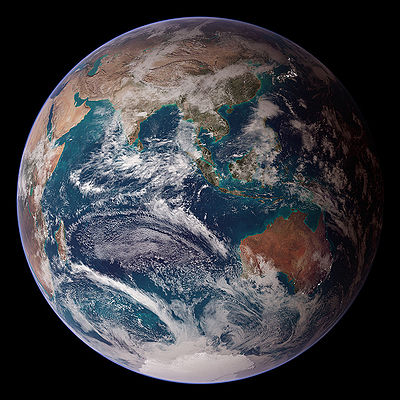Earth

Earth is the planet in the universe of Tamamna where humans originated. It is located in the Milky Way galaxy, third planet out from a mid-sized star.
Earth will not be described in detail in the Wongery, principally because there is ample information about it available in other sources. It is mentioned here principally for reference, as a measure with which to compare other worlds. However, like many worlds, if not all, Earth also exists in numerous alternate versions, and some of these alternate Earths are described here. The baseline Earth of which all others are considered to be variants is known as True Earth, though obviously this is something of a relative term—probably the inhabitants of each alternate Earth would consider their own Earth the true one, and others variations upon it.
Though in some science-fiction, Earth is called "Terra", this has never really caught on; "Earth" is already a sufficiently distinctive name that there's no need to Latinize it. There is no popular adjective corresponding to "Earth", however—the closest one being "earthling", which nowadays lies exclusively in the vocabular province of aliens in intentionally campy sci-fi—so "Terra" has been pressed into service to supply one, the most popular adjective to refer to Earth now being "Terran". (Despite its current science-fiction associations, however, "earthling" is by no means a neologism; the Oxford English Dictionary traces it back at least to 1593, when it was used by Elizabethan satirist Thomas Nashe in his (somewhat uncharacteristic) religious pamphlet "Christ's Tears Over Jerusalem". However, then and in the other early citations, the word refers not to inhabitants of the Earth as a planet, but to the Earth as the mortal plane, as distinct from the heavens. The first citation in which the word is used clearly in an astronomical, and not religious, sense is from 1949, in Heinlein's Red Planet—so perhaps the science-fiction association is justified after all.) The alternative adjective "Tellurian" is sometimes used, but much more rarely; sometimes "terrestrial" is used for this purpose, but it has several other meanings it may be better suited for, and is more often used to refer to things of the land (as opposed to of the ocean) or of mortal life, rather than to things of the planet Earth specifically, in addition to its æalogical meaning.
Somewhat similar onomastic knots entangle Earth's sun and moon. These do have specific names, "Sol" and "Luna", but they are rarely used, even by astronomers (except, again, in science fiction)—after all, the Earth only has one sun and one moon, so simply calling them "the Sun" and "the Moon" is sufficiently distinctive. Here, however, the colonization of other planets may make a difference; while "Earth" is a distinctive name for a planet, once there are other planets with other suns and moons involved then the designation of "the Sun" and "the Moon" becomes hopelessly ambiguous, depending on the planet the speaker is on. One could, perhaps, argue for the reservation of the word "Sun" for the Earth's sun, referring to others simply as stars, but this seems unsatisfactory for a number of reasons—partly because it removes a useful word to refer specifically to a star with planets orbiting it, but more importantly because it removes the word that the (currently hypothetical) inhabitants of other planets could use to refer specifically to the star their planet orbits. Of course, another word could be devised to fill that meaning, but that somewhat defeats the purpose of not coming up with another name for the Earth's sun. Besides, no such solution is reasonably thinkable for the case of the Moon, since the word "moon" has already been pressed into service for the natural satellites orbiting other planets in the Earth's own solar system.
It seems likely, then, that once other inhabited planets come into the mix, the names "Sol" and "Luna" for the Earth's sun and moon may enter much more common currency than they have today. If they do, though, this presents other problems, since the adjectives cognate to these words, "solar" and "lunar", are used to refer to suns and moons in general. What would be the adjectives, then, referring to the Earth's sun and moon, specifically? Should one reserve these adjectives for Sol and Luna themselves, and come up with other adjectives for other suns and moons? Aside from the awkwardness of inventing new words, this runs against the established use of the words; again, "lunar" has already been in widespread use to refer to moons of other planets as well as Earth's. Should one then devise new adjectives for the Earth's sun and moon, such as "terrisolar" and "terrilunar"? This is certainly possible, but seems unwieldy. Or should one just get by without adjectives for these bodies, referring to circumlocutions such as "the Earth's sun" and "the Earth's moon"? While this may not be entirely unthinkable, it would be rather inconvenient, and it seems inevitable someone would introduce appropriate adjectives at some point.
What course humanity takes, when and if other planets are colonized, remains, of course, to be seen (although the matter may be addressed for the fictional future Earths in the Wongery). For the most part, however, the Wongery will adhere to the following conventions: The words "solar" and "lunar", in the lower case, will refer to suns and moons in general, but capitalized will refer specifically to the Earth's Sun and Moon. (Cases of ambiguity—such as when the word begins a sentence, and it isn't clear from context whether it's referring to the Earth's sun or moon or any sun or moon—will be avoided by rephrasing the sentence.) Articles on specific future Earths with different conventions may follow those conventions instead.